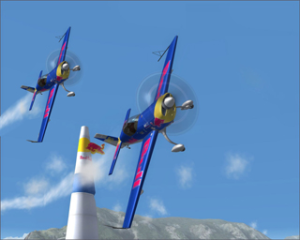Learning to Fly In Flight Simulator
Taking flying lessons in Flight Simulator is simple if you view the task as a series of steps. Follow the curriculum at your own pace, and most importantly, have fun. Your instructor, Rod Machado, has taught thousands of students to fly with his unique style of teaching, which includes a healthy dose of laughter with the lessons.
There are five categories of pilot ratings, each rewarding the successful evaluation of piloting skills you’ve learned with a Flight Simulator Pilot Certificate.
- Student Pilot—Learn the fundamentals of controlling the airplane
- Private Pilot—Expand your skills to include more difficult maneuvers and navigation
- Instrument Rating—Learn to fly solely by reference to the instruments
- Commercial Pilot—Step up to a bigger aircraft and learn more precise flying skills
- Airline Transport Pilot—Apply your flying skills toward learning to fly a Boeing jet
目次
How the Lessons Work
The Flight Simulator Flying Lessons are made up of ground school reading, interactive flying experiences, solo practice flights, and flight checkrides.
Ground School Reading
To start a lesson, click the link for the lesson you want to take. You can then read about the concepts behind the skills you’ll learn in the cockpit. Reading this material helps you breeze through the lesson with more success. When you’re ready to fly, click the Fly This Lesson link at the top or bottom of the page. Then you’ll see a briefing describing specifically what will happen during the flight as well as the criteria for successfully completing the lesson. Click the Fly Now button, and you’ll start the flying portion of the lesson.
Interactive Flying Lessons
Once in the cockpit, Rod has control of the airplane initially and will talk to you about what he has planned for the lesson. You will do a lot of the flying while listening to Rod’s instructions and explanations of each maneuver. If you are not flying as Rod requests, he’ll prompt you to make corrections. You’ll also notice text messages on the screen at this time, telling you the actions to take to correct the situation. Notice that messages turn from white to yellow and then to red as the corrective action is delayed longer and longer.
If you’re having trouble recognizing which instrument or control Rod refers to, hold your cursor over any item displayed on the panel. Within a moment, the name of the instrument pops up over the item. This is also a helpful way to learn the names of each instrument on the panel.
At the end of each flight, you have the opportunity to view the Flight Analysis page, which gives you a graphical look at the path you flew during the lesson. This tool may help you better understand where further practice is needed or confirm that you flew the flight within the tolerances stated at the beginning of the flight. For more information about Flight Analysis, see the Flight Analysis article in the Learning Center.
Note that not all menu items are active during the lessons. The lessons will not require you to make any changes to the aircraft, environment, or Flight Simulator. Likewise, not all lesson features are available in Virtual Cockpit. It is best to remain in Cockpit View throughout the lessons.
Solo Practice Flights
Practice will help you learn and hone the most essential skills needed to pass the examinations at the end of each category. Practice sessions start in the same way interactive lesson begin. Some fights include more information before the flight about the skills you will practice—they are like mini-lessons. Other solo flights only describe the conditions of and objectives for the flight you are about to take. Regardless, each solo flight provides you an open-ended experience to learn more and practice. To end a solo flight, press Escape.
Flight Checkrides
Start a checkride when you’re ready to demonstrate your flying skills to the examiner. You will not be given instruction on these flights. The Examiner will evaluate your flying throughout the flight to standards described in the briefing before the flight. At predetermined places during the flight, your examiner will decide if you’ve successfully demonstrated the required skills within the tolerances described in the briefing. If you have not, you’ll be asked to take the checkride again after some more practice. At that point, you can end the flight when you’re ready by pressing Escape. When you successfully pass a segment, you’ll be given instructions for the next portion of the flight. Once you pass each checkride, you’ll be awarded a certificate that you can print, frame, and hang on your wall.
What Else is There to Do?
After you’ve completed the lessons and checkrides you want, try flying some of the Missions—they’re a fun way to use your new skills. These fights give you the opportunity to try a variety of flying experiences that range from short, dramatic scenarios lasting a few minutes to lengthy, realistic flights of several hours.

